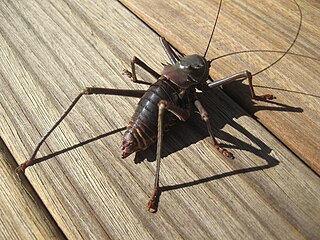
Insects in the family Tettigoniidae are commonly called katydids, or bush crickets. They have previously been known as "long-horned grasshoppers". More than 8,000 species are known. Part of the suborder Ensifera, the Tettigoniidae are the only extant (living) family in the superfamily Tettigonioidea.

The sooty oystercatcher is a species of oystercatcher. It is a wading bird endemic to Australia and commonly found on its coastline. It prefers rocky coastlines, but will occasionally live in estuaries. All of its feathers are black. It has a red eye, eye ring and bill, and pink legs.

The common chlorospingus, also referred to as common bush tanager, is a small passerine bird. It is a resident breeder in the highlands from central Mexico south to Bolivia and northwest Argentina. C. flavopectus in the loose sense is a notorious cryptic species complex, and several of the up to 25 subspecies recognized in recent times are likely to be distinct species. Some populations in fact appear to be more distinct than several other members of Chlorospingus.
The Nihoa conehead katydid is a species of katydid which is endemic to the Hawaiian island of Nihoa. It is one of the ten species in the genus Banza, all of them native to Hawaii, although it is the sister species to the remaining nine, and may belong in a separate genus. It gets its food mostly from plant leaves, but because of the low population, it does not do significant damage. Unlike Main Islands' species, whose males leap on the females before mating, the Nihoa variants sing to them. It is listed as a vulnerable species on the IUCN Red List, and as a "species of concern" under the Endangered Species Act.

The marble-faced bristle tyrant is a species of passerine bird in the family Tyrannidae. This species is sometimes placed in the genus Phylloscartes. It is found in Bolivia, Colombia, Ecuador, Peru, and Venezuela. Its natural habitat is subtropical or tropical moist montane forests.
Neduba extincta, the Antioch Dunes shieldback katydid, is an extinct species of katydid that was endemic to California, United States. It was not discovered until after its extinction.

Zabalius is a genus of bush crickets or katydids in the subfamily Pseudophyllinae. Its distribution is essentially Afrotropical. They are generally heavily built, tree-dwelling herbivorous katydids, capable of flight.

The long-legged armoured katydid is a species of katydid found in Namibia, and also in the northern portion of Northern Cape Province, South Africa, and southern Angola. It may possibly occur in Botswana. It is found in semi-arid and arid habitats, including the Kalahari Desert and the Namib Desert. It is threatened by habitat destruction, but is widespread and is not considered to be endangered.
The Richtersveld katydid is a species of katydid that is endemic to the Richtersveld National Park in South Africa. It occurs in semi-arid habitats of the Karoo biotope. It is threatened by livestock grazing and climate change.

The antlered thorny katydid is a species of katydid that is found in South Africa and Namibia. It can be found in semi-arid and arid habitats, including the Kalahari Desert, the Namib Desert, and in the Karoo and Fynbos biomes.
The striped thorny katydid is a species of katydid that is found in South Africa, predominantly in the Karoo biome.
The Marakele delicate katydid is a species of bush cricket or katydid orthopteran that is endemic to Marakele National Park in Limpopo Province, South Africa. It can be found within savanna and grassland biomes, and feeds on flowers and grass seeds, particularly Guinea grass. Because of its limited distribution, the IUCN considers it to be vulnerable to extinction, and is threatened by microclimatic changes.
Olszanowski's black-kneed katydid is a species of katydid that is endemic to the Western Cape and Northern Cape provinces of South Africa. It is mostly found in fynbos, but it can also be found in succulent and Nama Karoo biomes. Most records are from between 700 and 1,000 m.
Sopatas' black-kneed katydid is a species of katydid that is endemic to the Klein karoo biome of Western Cape province in South Africa. It is threatened by overgrazing by livestock and changes in weather patterns affecting its microhabitat.
Aprosphylus hybridus, the Namibian black-kneed katydid, is a species of katydid that is endemic to southern Namibia.
Griffiniana duplessisae, or Duplessis' agile katydid, is a species of katydid in the subfamily Phaneropterinae. It is endemic to Cederberg Mountains in South Africa.
Transkeidectes multidentis, the Transkei Shieldback is a species of katydid in the family Tettigoniidae. The species is endemic to Port St. Johns in South Africa.
Thoracistus peringueyi, the Peringuey's seedpod shieldback, is a species of katydid in the family Tettigoniidae. The species is endemic to South Africa, and is listed as critically endangered. It is only known from a male and female specimen that were collected prior to 1879 from a location in Lydenburg district.
Arytropteris pondo, the Pondo flat-necked shieldback, is a species of shield-backed katydid. The species is endemic to South Africa.
Austrodontura castletoni, known as Castleton's Flightless Katydid, is a species of katydid in the family Phaneropterinae. It is named after the artist Gavin Castleton. The species is endemic to South Africa.








